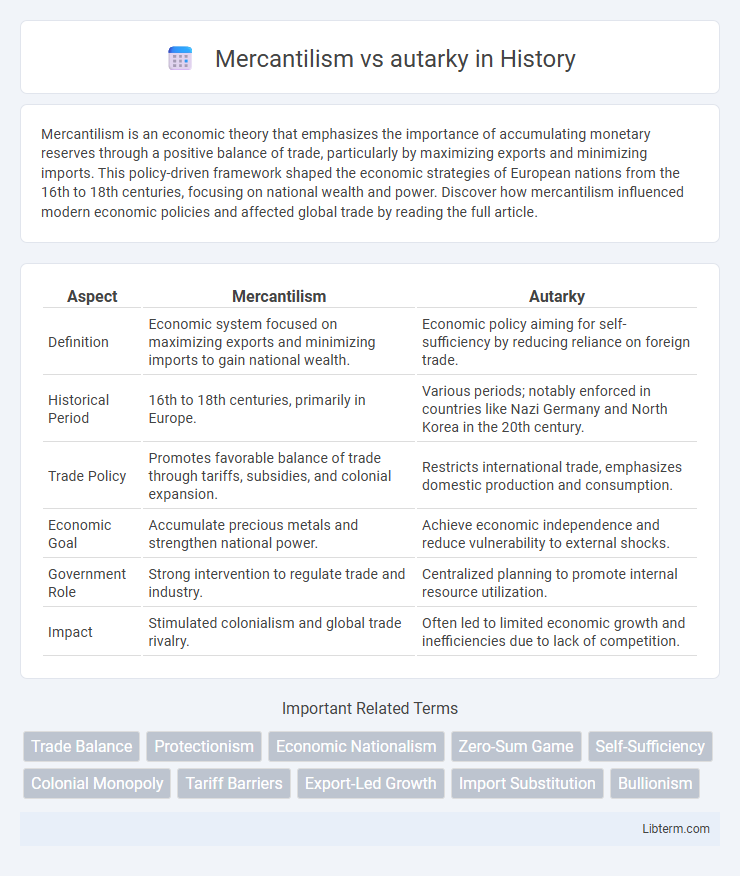Mercantilism is an economic theory that emphasizes the importance of accumulating monetary reserves through a positive balance of trade, particularly by maximizing exports and minimizing imports. This policy-driven framework shaped the economic strategies of European nations from the 16th to 18th centuries, focusing on national wealth and power. Discover how mercantilism influenced modern economic policies and affected global trade by reading the full article.
Table of Comparison
| Aspect | Mercantilism | Autarky |
|---|---|---|
| Definition | Economic system focused on maximizing exports and minimizing imports to gain national wealth. | Economic policy aiming for self-sufficiency by reducing reliance on foreign trade. |
| Historical Period | 16th to 18th centuries, primarily in Europe. | Various periods; notably enforced in countries like Nazi Germany and North Korea in the 20th century. |
| Trade Policy | Promotes favorable balance of trade through tariffs, subsidies, and colonial expansion. | Restricts international trade, emphasizes domestic production and consumption. |
| Economic Goal | Accumulate precious metals and strengthen national power. | Achieve economic independence and reduce vulnerability to external shocks. |
| Government Role | Strong intervention to regulate trade and industry. | Centralized planning to promote internal resource utilization. |
| Impact | Stimulated colonialism and global trade rivalry. | Often led to limited economic growth and inefficiencies due to lack of competition. |
Introduction to Mercantilism and Autarky
Mercantilism is an economic theory from the 16th to 18th centuries advocating for a positive balance of trade to increase national wealth through government regulation and accumulation of precious metals. Autarky refers to a nation's policy of economic self-sufficiency, aiming to minimize reliance on international trade by producing all necessary goods domestically. Both concepts emphasize national economic strength but differ fundamentally in their approach to trade and resource management.
Historical Origins of Mercantilism
Mercantilism originated in Europe during the 16th to 18th centuries as governments sought to strengthen national economies through controlled trade and accumulation of precious metals. This economic policy emphasized exporting goods to achieve a favorable balance of trade, often supported by colonial expansion and state intervention. Unlike autarky, which promotes self-sufficiency, mercantilism relies on external trade to build wealth and national power.
Development and Principles of Autarky
Autarky development centers on achieving economic self-sufficiency by minimizing dependence on international trade, emphasizing domestic production of goods to sustain internal markets. The principles of autarky include strict control over imports and exports, promotion of national industries through state intervention, and the belief that economic independence strengthens national security and stability. Unlike mercantilism, which thrives on accumulating wealth via trade surpluses and colonial expansion, autarky seeks to insulate the economy from global market fluctuations and geopolitical risks.
Core Economic Theories: Mercantilism Explained
Mercantilism emphasizes accumulating wealth through a positive trade balance, advocating for government intervention to maximize exports and minimize imports. It supports policies like tariffs, subsidies, and monopolies to protect domestic industries and increase national reserves of precious metals. This theory contrasts autarky, which strives for economic self-sufficiency by limiting foreign trade altogether.
Core Economic Theories: Autarky Explained
Autarky represents an economic system focused on self-sufficiency, minimizing reliance on international trade to protect domestic industries and conserve national resources. It contrasts with mercantilism, which promotes accumulating wealth through trade surpluses and foreign markets. Core economic theories of autarky emphasize resource allocation internally, fostering resilience against global market fluctuations but often limiting efficiency and growth potential.
Key Differences Between Mercantilism and Autarky
Mercantilism emphasizes maximizing exports and accumulating precious metals through controlled trade policies, promoting economic growth via external markets and colonial expansion. Autarky focuses on self-sufficiency by minimizing imports and relying on domestic production to reduce dependence on foreign economies. While mercantilism relies on international trade imbalances to build national wealth, autarky aims for economic independence by restricting trade and fostering internal resource utilization.
Case Studies: Mercantilism in Global History
Mercantilism shaped the economic policies of European powers such as England, France, and Spain during the 16th to 18th centuries, emphasizing the accumulation of gold and silver through a positive balance of trade. England's Navigation Acts and France's Colbertism are prime examples of mercantilist strategies designed to control colonial trade and bolster national wealth. These cases illustrate how mercantilism prioritized state intervention and colonial expansion over self-sufficiency, contrasting sharply with autarkic policies that seek economic independence by minimizing foreign trade.
Case Studies: Autarky in Practice
Autarky, as demonstrated by North Korea's economic policies, emphasizes self-sufficiency by minimizing foreign trade to sustain national industries and resources internally. Historical case studies reveal that autarkic strategies often lead to resource inefficiencies and technological stagnation compared to mercantilist economies that leverage export-driven growth. Examples such as Nazi Germany's Reichswerke and Francoist Spain show mixed outcomes where partial autarky bolstered initial industrial capacity but ultimately hindered long-term economic adaptability.
Impacts on Trade and Economic Growth
Mercantilism emphasizes accumulating wealth through positive trade balances by exporting more than importing, which can stimulate short-term economic growth but often leads to trade conflicts and inefficiencies. Autarky, or economic self-sufficiency, restricts imports to protect domestic industries, resulting in limited access to global markets, reduced specialization, and slower long-term economic growth. Both strategies impact trade dynamics significantly, with mercantilism promoting active trade engagement and autarky limiting international exchange, affecting overall economic development and innovation rates.
Modern Relevance: Mercantilism vs. Autarky Today
Mercantilism and autarky shape modern economic policies through protectionist trade measures and self-sufficiency goals, evident in tariffs, subsidies, and strategic resource management. Countries like China leverage mercantilist strategies to boost exports and accumulate reserves, while North Korea exemplifies autarky with strict import limitations and domestic production emphasis. The ongoing global supply chain disruptions and geopolitical tensions highlight the tension between mercantilist export-led growth and autarkic isolationism in contemporary economic strategies.
Mercantilism Infographic

 libterm.com
libterm.com